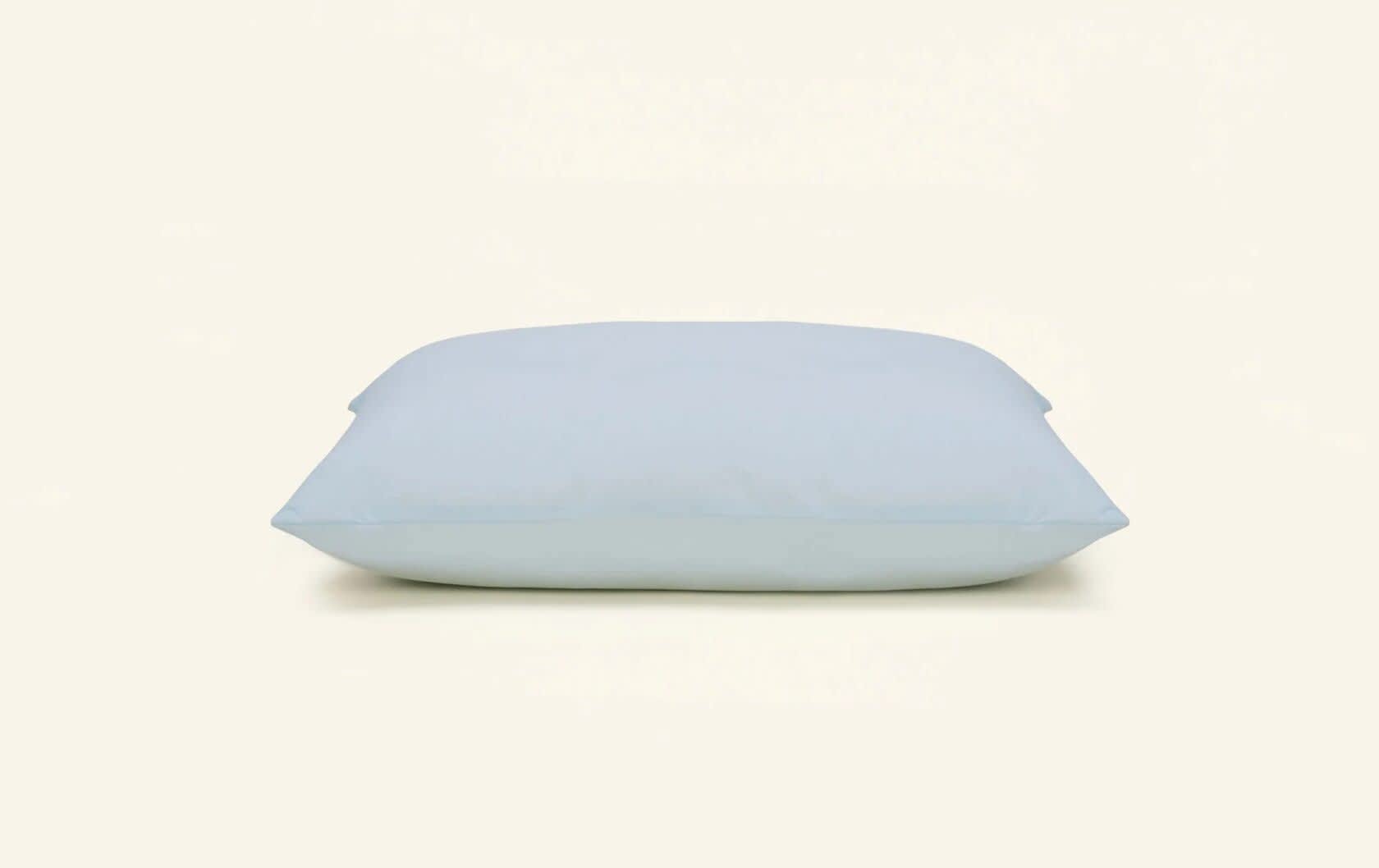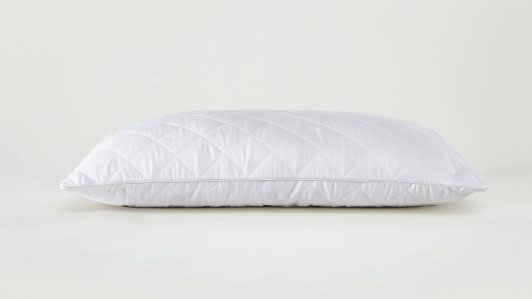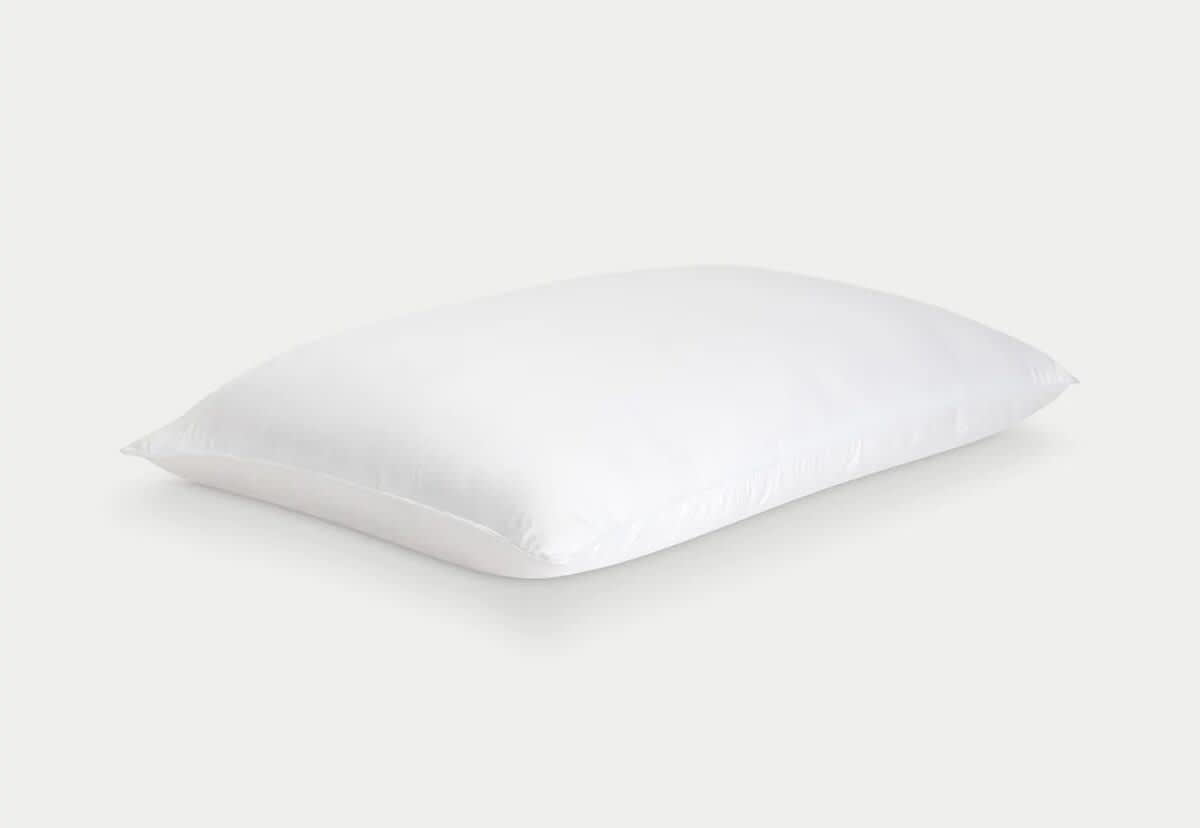On This Page
The Best Cooling Pillows
Our Top Picks
-
Best Overall
Slumber Cloud UltraCool Pillow -
Best Value
Sijo FluffBase Eucalyptus Pillow -
Most Comfortable
Sleep Is the Foundation Shredded Memory Foam Pillow -
Best Luxury
Cozy Earth Silk Pillow -
Best for Side Sleepers
Layla Kapok Pillow -
Best for Neck Pain
Sijo FlexCool Memory Foam Pillow
Best Overall
Highlights
Highlights
- Two firmness options provide choices for any sleep position
- Cooling fabric designed to regulate temperature
- OEKO-TEX 100 certification ensures pillow is free from harmful substances
Ideal For
- Side and back sleepers
- People looking for the feel of down without the heat retention
- Sleepers who want easy maintenance
Full Details
Best Value
Highlights
Highlights
- Down alternative fill mimics the softness of real down
- Available in two loft/firmness levels
- Cover composed of smooth, moisture-wicking Tencel fabric
Ideal For
- People with down allergies
- Those who prefer to buy products that don't use animal-based materials
- Budget shoppers
Full Details
Most Comfortable
Highlights
Highlights
- Adjustable design lets you customize the pillow for firmness and loft
- Cross-cut memory foam contours closely without trapping too much heat
- Mesh side panels on the cover help promote airflow
Ideal For
- Combination sleepers who frequently change positions
- Hot sleepers
- Shoppers with limited budgets
Full Details
Best Luxury
Highlights
Highlights
- High-end materials offer a luxurious sleeping experience
- Moisture-wicking fabric pulls sweat away from the body
- Durable weave reduces pilling
Ideal For
- Side sleepers
- Sleepers interested in a soft yet durable luxury pillow
- People shopping for a long-lasting pillow
Full Details
Best for Side Sleepers
Highlights
Highlights
- Kapok tree fibers give pillow a soft and silky feel
- Shredded memory foam promotes contouring
- Adjustable fill allows for custom height and firmness
Ideal For
- Side and back sleepers
- People who want a supportive pillow with a high-end look
- Those interested in natural and durable materials
Full Details
Best for Neck Pain
Highlights
Highlights
- Adjustable for firmness and loft to accommodate different sleep positions
- Plush fill blend consists of shredded memory foam and down alternative fibers
- Nylon-blend cover is breathable and long-lasting
Ideal For
- Those who want a pillow they can customize to meet their needs
- Hot sleepers and people prone to night sweats
- Shoppers seeking a pillow that's easy to keep clean
Full Details
How We Test Pillows
We test pillows against the same set of strict standards that we use for other pillow types, but we pay close attention to several factors that set different pillows apart. In addition to firmness, conforming, and ease of cleaning, we also measure breathability. Many sleepers choose specific materials for their cool feel. To determine how well a pillow regulates temperature, we use thermal sensors that measure heat retention and we try them ourselves too, taking notes on how warm or cool we think a pillow feels after use.
How Do Cooling Pillows Work?
Cooling pillows are designed to regulate a sleeper’s temperature by promoting airflow and reducing heat buildup in the head and neck. Manufacturers use various materials and design features to create cooling pillows. Common materials include gel-infused foams, latex, kapok, and down alternatives.
Cooling pillows often feature design elements like air channels or a higher loft. Air channels can increase airflow, while a higher loft can reduce heat buildup by preventing a sleeper’s head from sinking too deeply into the pillow. Some manufacturers may also incorporate cooling technology into the pillow cover, such as a phase change material that draws heat away from the body or moisture-wicking fabrics like cotton or bamboo.
Sleepers looking for the best pillow should consider their own sleeping preferences and habits, as well as the materials and features that will best suit their needs.
What Are Cooling Pillows Made of?
There are two major types of temperature-regulating fills used in cooling pillows. Natural fills, including materials like buckwheat, silk, kapok, or cotton, are derived from plants or animals. These fills are often breathable, eco-friendly, and have a longer lifespan. Synthetic fills, such as shredded memory foam, gel memory foam, or foams infused with copper, typically come at a lower price-point and are designed to be allergy-resistant and enhance certain characteristics of the pillow.
Natural vs. Synthetic Cooling Pillows
| Natural Cooling Pillows | Synthetic Cooling Pillows | |
| Description | Natural cooling pillows contain naturally made materials, such as silk, kapok, cotton, or buckwheat | Synthetic cooling pillows consist of man-made fills, such as shredded memory foam, infused foams, or cooling gels |
| Pros |
|
|
| Cons |
|
|
If you sleep hot, make sure you think about both fill and cover materials. It doesn’t do any good if you get a breathable latex fill that has a heat-trapping cover. Natural materials like linen, cotton, and bamboo-derived rayon usually have solid airflow and work well as cooling shell fabrics.
What Pillows Work Best to Relieve Night Sweats?
The best pillow for relieving night sweats is different for every sleeper. In general, pillows that work well for night sweats include breathable, moisture-wicking covers and fills that promote airflow. There are many types of temperature-regulating fills and cover materials to choose from. Some sleepers may find latex pillows with cotton covers reduce night sweats, while others prefer a cooling gel-infused foam core with a phase change material cover.
The right material and fill combination also depends on your sleep position and individual needs. For instance, if you’re a back sleeper, you should opt for a medium loft pillow that contours to the head to keep it aligned with the spine. Side sleepers, on the other hand, benefit from a pillow with a high loft that elevates their head and helps maintain spinal alignment.
Pillow Height, Firmness, Support, and Keeping Your Spine Aligned
A pillow’s height and firmness affect how well it supports healthy spinal alignment. To find the right loft and firmness, sleepers should consider their primary sleep position. For example, side sleepers benefit from a higher loft and a firmer pillow compared to people who sleep on their stomach or back.
The Height (or Loft) of Your Pillow
The height of a pillow, also called its loft, plays a crucial role in determining the position of the head and neck during sleep, which in turn impacts the alignment of the spine. Achieving healthy spinal alignment during sleep requires the appropriate pillow height for a person’s preferred sleep position.
We’ll cover the recommended pillow loft for different sleeper types so you can choose the appropriate loft for your sleep position.
How Firm Should Your Cooling Pillow Be?
A pillow’s firmness refers to how hard or soft it feels. Firmness is generally described as a range, from soft to medium to firm. The right level of firmness for a sleeper depends on their preferences, weight, and sleeping position.
To help you find the right level of firmness, we’ll cover the ideal firmness for each sleeping position.
Don’t overlook moldability during your research. The more a pillow adapts to your head shape, the less room there is around it for airflow. If the fill is breathable, that’s not a huge deal but it can make your pillow pretty warm if the fill is a material that tends to retain heat.
It’s Cool to Support Your Spine and Keep It Aligned
Support is a crucial aspect of picking the right pillow, as it relates to how well the pillow promotes proper spinal alignment. Proper support from a pillow is necessary to ensure that the head, neck, and back remain in a neutral position, reducing the risk of neck pain and stiffness in the morning. Each sleeping position and body type requires a different level of support for comfortable and restful sleep.
Cool Tips to Help Hot Sleepers Sleep Comfortably
Picking the right pillow is only one way to avoid overheating at night. Other factors, like your choice of bedding and room temperature, can also contribute to whether you sleep hot or cool.
Avoid Memory Foam: Memory foam can restrict airflow and cause a pillow to retain heat. When looking for a cooling pillow that also provides the contouring properties of memory foam, try pillows with open-cell memory foam, shredded memory foam, or memory foam infused with cooling gel or copper. You may also want to avoid memory foam mattresses unless they feature similar cooling technologies. More breathable mattress types include latex, innerspring, and hybrid models.
Take a Look at Your Bedding: When sleeping you’re surrounded by materials, from pajamas and mattress toppers to pillows and comforters. For those who overheat easily, it’s important to pick breathable materials such as cotton, linen, silk, or bamboo.
Try to Keep Your Bedroom Cool: To stay cool at night, try lowering your thermostat to around 65 to 68 degrees Fahrenheit, a range that experts suggest is an ideal temperature for sleep. Bedroom fans can also help keep air moving and prevent your bedroom from feeling too warm or stuffy.
Explore More Pillows
If you’re looking for a particular type of pillow, check out our other guides below.






